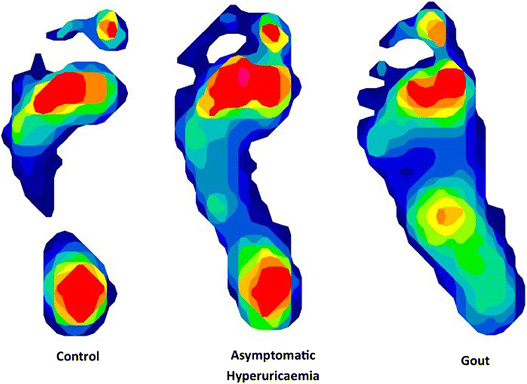Spatiotemporal gait parameters and plantar pressure distribution during barefoot walking in people with gout and asymptomatic hyperuricemia: comparison with healthy individuals with normal serum urate concentrations
- PMID: 27134680
- PMCID: PMC4851792
- DOI: 10.1186/s13047-016-0147-4
Spatiotemporal gait parameters and plantar pressure distribution during barefoot walking in people with gout and asymptomatic hyperuricemia: comparison with healthy individuals with normal serum urate concentrations
Abstract
Background: To identify spatiotemporal gait parameters and plantar pressure distribution during barefoot walking in people with gout and people with asymptomatic hyperuricemia by comparing them to healthy individuals with normal serum urate concentrations.
Methods: Eighty-seven participants were included: 24 with gout, 29 with asymptomatic hyperuricemia and 34 age- and sex-matched normouricemic control participants. Spatiotemporal parameters of gait were assessed during level barefoot walking using a GAITRite® walkway. Peak plantar pressure and pressure time integrals were recorded using a TekScan MatScan®. Results were adjusted for age and body mass index.
Results: Compared to normouricemic control participants, participants with gout demonstrated increased step time (P = 0.022) and stance time (P = 0.022), and reduced velocity (P = 0.050). Participants with gout also walked with decreased peak pressure at the heel (P = 0.012) and hallux (P = 0.036) and increased peak pressure (P < 0.001) and pressure time integrals (P = 0.005) at the midfoot. Compared to normouricemic control participants, participants with asymptomatic hyperuricemia demonstrated increased support base (P = 0.002), double support time (P < 0.001) and cadence (P = 0.028) and reduced swing time (P = 0.019) and single support time (P = 0.020) as well as increased pressure at the midfoot (P = 0.013), first metatarsal (P = 0.015) and second metatarsal (P = 0.007).
Conclusion: During barefoot walking, people with gout walk slower with plantar pressure patterns suggestive of apropulsive and antalgic gait strategies. Individuals with asymptomatic hyperuricemia also demonstrate altered barefoot gait patterns when compared to normouricemic control participants. Clinicians may consider dynamic gait outcomes when assessing and managing foot and lower limb related pain and disability in individuals with gout and asymptomatic hyperuricemia.
Keywords: Asymptomatic hyperuricemia; Gait; Gout; Plantar pressure.
Figures
Similar articles
-
The effect of good and poor walking shoe characteristics on plantar pressure and gait in people with gout.Clin Biomech (Bristol). 2014 Dec;29(10):1158-63. doi: 10.1016/j.clinbiomech.2014.09.009. Epub 2014 Oct 2. Clin Biomech (Bristol). 2014. PMID: 25304642
-
Foot-related pain and disability and spatiotemporal parameters of gait during self-selected and fast walking speeds in people with gout: A two-arm cross sectional study.Gait Posture. 2016 Feb;44:18-22. doi: 10.1016/j.gaitpost.2015.11.004. Epub 2015 Nov 12. Gait Posture. 2016. PMID: 27004627
-
Are ultrasound features at the first metatarsophalangeal joint associated with clinically-assessed pain and function? A study of people with gout, asymptomatic hyperuricaemia and normouricaemia.J Foot Ankle Res. 2017 May 22;10:22. doi: 10.1186/s13047-017-0203-8. eCollection 2017. J Foot Ankle Res. 2017. PMID: 28539973 Free PMC article.
-
The influence of population characteristics and measurement system on barefoot plantar pressures: A systematic review and meta-regression analysis.Gait Posture. 2019 Jan;67:269-276. doi: 10.1016/j.gaitpost.2018.10.030. Epub 2018 Oct 26. Gait Posture. 2019. PMID: 30391749
-
Contributions to the understanding of gait control.Dan Med J. 2014 Apr;61(4):B4823. Dan Med J. 2014. PMID: 24814597 Review.
Cited by
-
Cutaneous Calcified Mass of Foot in Pseudohypoparathyoidism: Case Report.Medicina (Kaunas). 2024 Apr 4;60(4):595. doi: 10.3390/medicina60040595. Medicina (Kaunas). 2024. PMID: 38674241 Free PMC article.
-
Changes in hoof kinetics and kinematics at walk in response to hoof trimming: pressure plate assessment.J Vet Sci. 2018 Jul 31;19(4):557-562. doi: 10.4142/jvs.2018.19.4.557. J Vet Sci. 2018. PMID: 29486539 Free PMC article.
-
Foot structure, pain and functional ability in people with gout in primary care: cross-sectional findings from the Clinical Assessment Study of the Foot.J Foot Ankle Res. 2019 Jan 25;12:8. doi: 10.1186/s13047-019-0317-2. eCollection 2019. J Foot Ankle Res. 2019. PMID: 30700995 Free PMC article.
-
Impact of Sex and Velocity on Plantar Pressure Distribution during Gait: A Cross-Sectional Study Using an Instrumented Pressure-Sensitive Walkway.J Funct Morphol Kinesiol. 2022 Nov 28;7(4):106. doi: 10.3390/jfmk7040106. J Funct Morphol Kinesiol. 2022. PMID: 36547652 Free PMC article.
-
Clinically-evident tophi are associated with reduced muscle force in the foot and ankle in people with gout: a cross-sectional study.J Foot Ankle Res. 2017 Jun 19;10:25. doi: 10.1186/s13047-017-0207-4. eCollection 2017. J Foot Ankle Res. 2017. PMID: 28649283 Free PMC article.
References
Publication types
MeSH terms
Substances
LinkOut - more resources
Full Text Sources
Other Literature Sources
Medical



